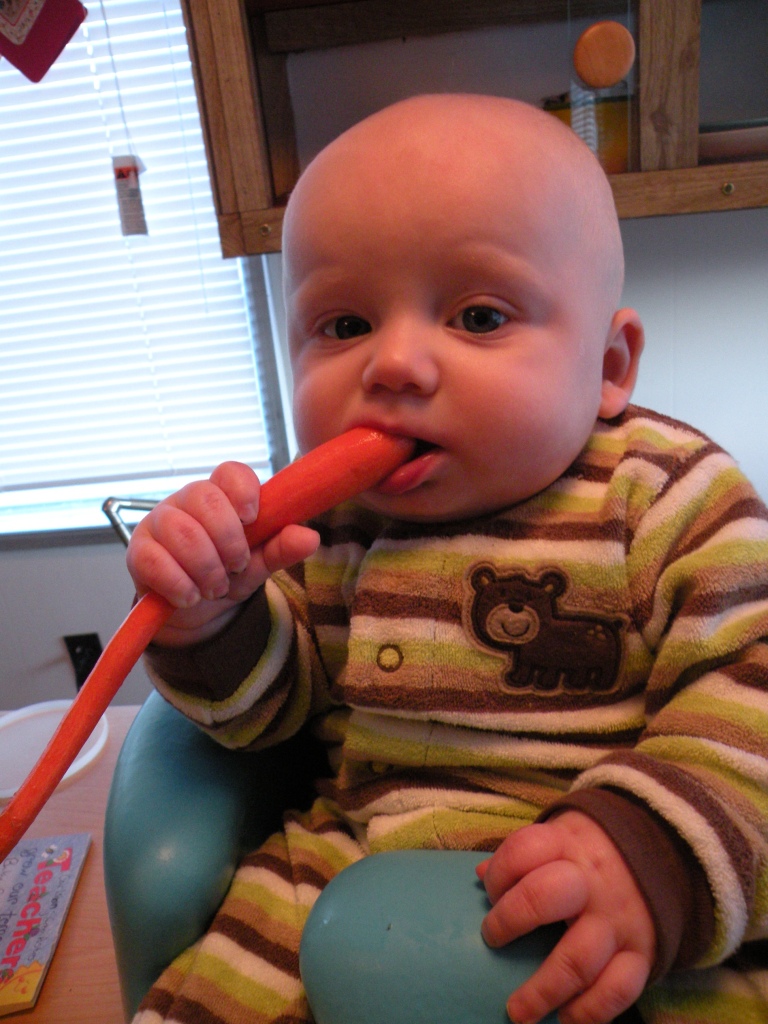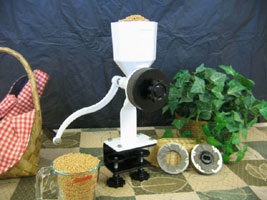Real Baby Food
The time is rapidly approaching when Job can partake in his first meal of solid foods. So I began looking up information on the subject, knowing from other moms that it can be a somewhat tricky field to navigate. Also, I despise most contemporary nutrition advise as I find it is often filled with errors, so I wanted to research this topic on my own.
I read the book Real Food for Mother and Baby by Nina Planck and I stopped with this book because everything in it-or mostly everything-made so much sense that I did not feel the need to look further. I share this information with you now in hopes that it will be of value and that it will open up a whole new interesting world of when and what to feed baby. Of course, I am not an expert on this subject, I am simply sharing what I have learned. Proceed at your own risk;-)
 Job is not yet sitting up on his own, but I figured that he could at least start exploring foods. I peeled and washed a whole carrot and let him taste and gum it. He looks bored in this picture, but he had lots of fun exploring his new chew toy!
Job is not yet sitting up on his own, but I figured that he could at least start exploring foods. I peeled and washed a whole carrot and let him taste and gum it. He looks bored in this picture, but he had lots of fun exploring his new chew toy!This book is filled with inspiring information, and I must resist the urge to simply recite the whole book. I have tried to highlight the things I found most helpful. But I highly recommend checking the book out for yourself. You will find yourself refreshed by Nina’s wholesome and commonsense advice.
Nina Planck begins with the assertion that the best time to start feeding solid foods is when baby is sitting up by himself. This indicates a strong control of the trunk portion of their body, presumably so that the baby will be more prone to swallowing rather than spitting out food. Certainly you can start baby before he is sitting up on his own, but this gives an idea of when to begin. Job is not yet sitting on his own, I think because his head is still about 2/3 of his body!
Nina is an advocate for a food movement called “real foods.” This movement centers around eating the traditional foods of our fore fathers, basic foods like eggs, milk, cheese, yogurt, vegetables, whole grains, healthy fats like lard, butter, and olive oil, and meat. FYI, when she refers to eggs, milk, and cheese she is referring to raw milk, free range eggs, and raw cheese, and grass-fed beef and free range chicken. However, if these are not readily available, the products on the shelves at Wal-Mart will mostly do (minus a few exceptions such as fake cheese and yogurts laden with sugar). The foods in their natural state however, like raw milk, is the most beneficial, filled with vitamins, minerals, probiotics, and beneficial fat. For more information on this subject refer to Nina’s book, www.westonaprice.org, or possibly even a future blog posting if I can be so amazingly organized (crossing fingers!).
So what foods are best to begin with? According to Nina, begin with any and every fruit and vegetable you like. She has found very little evidence to support that you should feed certain foods (like citrus and eggs) at certain ages. Especially if a baby has been breast fed for the first 6 months, their propensity towards allergies is greatly diminished. That aside, armed with real foods and common-motherly-sense, Nina recommends what she deems the “scientific feeding method.”
This method involves: 1) placing baby in highchair, 2) setting out foods in front of baby such as sliced avocado, pieces of banana, cooked sweet potatoes, or cooked egg yolk, 3) allow baby to explore the foods on his own-according to Niles Newton author of The Family Book of Child Care, babies are capable of feeding themselves at 5 months, 4) repeat once or twice daily and gradually baby will learn to place food in mouth, gum it around, and even swallow!
I have yet to decide if I’m brave enough to place in front of my baby chopped, rather than pureed, food, but according to Nina, it works-of course be sure to always supervise baby (hence the motherly commonsense). This saves the time and effort of pureeing and freezing foods, purchasing baby food, as well as trying to force food down a baby only interested in spitting it out. If baby is hungry, he will eat! And of course the greatest hope is that you can enjoy your own hot meal while baby eats along with you. Depending on your diet, you can also share your hot meal with baby being careful to stir clear of anything refined, such as refined flours and sugars.
Here is a list of foods that Nina finds perfectly acceptable for a baby of 6 months: ground beef and lamb, chicken (cut into long thin pieces), fish, bone jelly (soup stock made from chicken/beef/lamb/turkey bones), eggs, applesauce, bananas, oranges, pineapple, peaches, tomatoes, carrots, cabbage, peas, steamed beets, baked potatoes, sweet potatoes, avocado, fresh coconut, coconut milk, and dairy products (however, dairy products should be things like raw milk and raw cheese). Grains, including rice, should still be kept until the baby is about a year old because the gluten in these products can still be difficult for a baby to digest.
Mix into babies food things like olive oil, butter, and coconut oil. These are healthy fats and aid in baby’s (and ours, we should also consume these nutritious foods) digestion, building cell walls, immunity, helping bones create calcium, fight inflammation, and much more. Also, don’t be afraid to season with salt so long as it is unrefined sea salt. This salt is very nutritious for the body, refined, iodized salt, however, is devoid of nutrients and unusable to the body.
So there you have it! This is condensed information on how to feed your baby, but you have all the steps and the highlighted details from my book. But again, I highly recommend this book for more specific information on foods. This book also discusses real foods for fertility, pregnancy, and breastfeeding.
I look forward to using the “scientific feeding method” on Job and seeing for myself how well he can learn to feed himself. I also feel much better equipped for growing a healthy baby and hope that you do too.
For the record, Laura has nursed Job 100% since birth and pumped when he was in the NANIC (Neo-natal intensive care). That is a HUGE accomplishment.
Thanks for allowing me to share pictures of my grandson Job, almost six months old. Marilyn Moll, The Urban Homemaker








